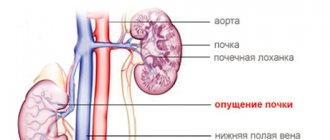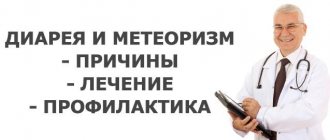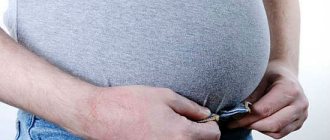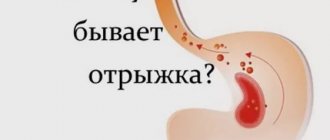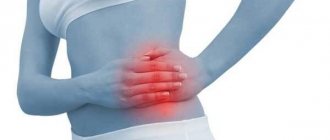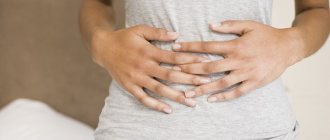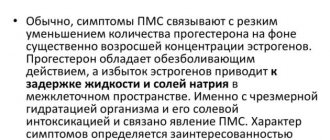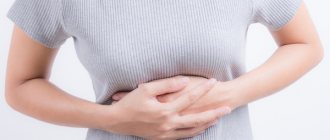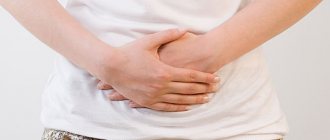Etiology of pain and bloating
Medical experts identify a huge number of reasons for the feeling of fullness in the right or left hypochondrium.
Appendicitis
If there is heaviness in the right hypochondrium, which quickly transforms into acute pain in the lower abdomen, inflammation of the appendix of the intestine is suspected. This pathological condition requires immediate medical intervention, since it threatens the patient’s life. Acute appendicitis is additionally accompanied by the following symptoms:
- increased body temperature;
- development of signs of intoxication;
- decreased appetite;
- muscle weakness;
- nausea and vomiting.
With the development of acute appendicitis in children or the elderly, a blurred clinical picture is observed. Therefore, if you have the slightest suspicion of the presence of pathology, you should consult a doctor.
Gynecological diseases
A common cause of acute pain in the left or right side of the lower abdomen in women is called ectopic pregnancy. In this case, the fertilized egg begins its development not in the uterine cavity, but outside it. This is also indicated by the appearance of signs of pregnancy - nausea, vomiting, swelling of the mammary glands, cessation of menstruation. In the absence of medical care, the tissue of the organ where the fetus develops ruptures, which provokes internal bleeding.
The development of a feeling of fullness in the side in women is observed with adnexitis. This disease is accompanied by the appearance of uncharacteristic vaginal discharge, increased body temperature, and increased urination.
With the development of an ovarian cyst, discomfort also appears in the lower abdomen. When the tumor stalk is torsed, intense pain occurs, which is combined with vaginal bleeding and a sharp deterioration in well-being.
Digestive system diseases
The appearance of pain in the right or left side under the ribs and severe bloating most often indicate the development of the following pathologies:
- Cholecystitis. Accompanied by a violation of the outflow of bile and its stagnation. The disease often manifests itself in the presence of stones in the organ. The pain is short-term, but increases significantly with stress or physical activity. Additional symptoms are nausea, vomiting mixed with bile, bitterness in the mouth.
- Duodenitis. With inflammation of the mucous membrane of the duodenum, increased gas formation, weakness, heaviness in the abdomen, and belching are observed. The causes of the disease are poor nutrition, alcoholism, and helminthic infestations.
- Gastritis. When the gastric mucosa is inflamed, the pain is characterized as dull, aching. Unpleasant sensations under the left rib in the front appear after eating (after about 15 minutes). Additional symptoms are nausea, belching, periodic diarrhea, hypovitaminosis.
- Hepatitis. Inflammatory liver disease is predominantly viral in origin. The main symptom is the development of jaundice. The disease begins with a slight increase in body temperature and general weakness. Due to the increase in the size of the liver, its protrusion is observed in the area of the right hypochondrium.
- Cirrhosis. The right side begins to hurt only in the later stages of the disease, when irreversible changes have occurred in the tissues of the organ. Early signs of cirrhosis include bloating, weakness, diarrhea, significant weight loss, and an increase in body temperature to low-grade levels.
With pancreatitis, severe bursting pain of a girdle nature appears. The sick person is also bothered by nausea and vomiting, which does not bring relief, and belching air. With pancreatitis, stool changes. It becomes mushy and contains undigested food particles.
Kidney pathologies
Pyelonephritis is accompanied by severe pain that appears in the lower back or side, radiating to the shoulder blades, groin, and perineum. With inflammation of the kidney tissue, discomfort increases due to intense physical activity, stress, and drinking large amounts of water.
Additional symptoms of pyelonephritis are:
- increased blood pressure;
- frequent urination;
- increased body temperature;
- prostration;
- nausea;
- the appearance of pain when urinating.
A person can and will swell in the side if there are kidney stones. When a calculus disrupts the flow of urine, paroxysmal pain appears. The patient's condition worsens due to frequent urge to urinate. If there are kidney stones, blood is found in the urine.
What to do if there is pain in the right side of the abdomen
Finally, let's figure out what to do if there is pain in the right side of the abdomen. First of all, there is no need to panic. Remember that such manifestations are extremely rarely the cause of sudden death. The first thing to do in such a situation is to take the most comfortable position. It is best if you sit in a soft chair or lie down on the sofa. This pose will help reduce the intensity of the pain syndrome and analyze its nature. In this case, it is important to take into account the presence of the following accompanying factors:
- Pregnancy.
- Existing chronic diseases.
- Other symptoms (nausea, diarrhea, fever, weakness).
- The strength of pain manifestations.
Having put all these symptoms together and soberly assessing the situation, you need to choose one of three options for seeking medical help.
- Visit a doctor on your own (for mild symptoms).
- Calling a local doctor to your home (for moderate symptoms).
- Call an ambulance (in case of severe pain).
Important! An attempt to independently relieve a pain attack with the help of medications in such a situation is contraindicated, since it can mask the pathological process and complicate the early diagnosis of the disease.
https://youtu.be/wsIR6803nMc
Diagnostics
If the abdomen becomes very bloated, pain and intestinal dysfunction develop, the patient is recommended to undergo a comprehensive examination of the body. Laboratory diagnostics:
- general blood analysis;
- urine test;
- blood biochemistry;
- coprogram;
- blood test for the presence of viral hepatitis.
Comprehensive diagnostics includes ultrasound examination of internal organs, CT, and MRI. If gastrointestinal pathology is suspected, gastroscopy and colonoscopy are performed.
Symptoms
Flatulence in adults is usually accompanied by symptoms such as:
- Abdominal pain of varying intensity;
- Feeling of fullness in the abdominal cavity;
- Rumbling;
- Heartburn, nausea;
- Headache;
- Constipation or, conversely, diarrhea;
- Poor appetite;
- Weight gain;
- General malaise;
- Dyspnea;
- Arrhythmia.
In pregnant women, an enlarged uterus puts pressure on the intestines, which, in turn, function less well due to the influence of hormones. Flatulence occurs, accompanied by constipation.
Newborns also experience pain and colic in the colon, and to understand what is happening to the baby, you need to observe his behavior.
Therapy methods
Treatment of flatulence and discomfort in the hypochondrium should be carried out taking into account the reasons that provoked them. If intense pain develops, it is recommended to call an ambulance. Taking painkillers in this case is prohibited, as this may blur the clinical picture.
Drug therapy for the occurrence of the above diseases includes:
- Antispasmodics. Eliminates spasm of smooth muscles, which relieves pain.
- Hepatoprotectors. The drugs strengthen the liver and restore its functioning.
- Probiotics. They normalize the intestinal microflora, which eliminates excessive accumulation of gases.
- Antibiotics. Used to treat infectious diseases of bacterial origin.
- Carminatives. Eliminates gas bubbles in the intestines, which eliminates bloating.
- Antacids. Neutralizes the negative effect of hydrochloric acid on the mucous membrane of the digestive tract.
Disease therapy is also carried out by following a gentle diet. The patient is advised to exclude fatty, smoked, fried, carbonated drinks, excessively sweet and salty foods from the diet. You need to eat small meals, but often. It is necessary to give up late dinner, overeating, coffee and tea. It is recommended to drink at least 1.5 liters of plain water per day.
Traditional treatment
For problems with the gallbladder, medications containing immortelle are prescribed. The plant can be used to make simple tea, which can be consumed several cups a day. Beetroot, corn silk, rose hips, and peppermint are also used to treat inflammatory diseases of the gallbladder.
To restore liver function, decoctions of milk thistle and hop cones are prescribed. In the presence of pyelonephritis, burdock root, corn silk, and bearberry are used. Oatmeal jelly is useful for the efficient functioning of the digestive system. It has an enveloping effect, normalizes blood composition, and stimulates the body's protective functions.
Folk remedies for the treatment of flatulence
In the process of treating disorders in the digestive system, manifested by bloating and pain, herbal medicine gives good results. There are a huge number of recipes to eliminate these unpleasant symptoms.
Some of the best are:
- Chamomile flower decoction . Brew flowers (1 tablespoon) in boiling water (250 ml), strain after 4 hours. Take 50 ml three times a day before meals for a week.
- Dandelion root infusion . Place the roots (1 tablespoon) in boiled water at room temperature and let steep for 10 hours. Strain, take 50 ml four times a day for ten days.
- Infusion of tansy flowers . Brew dried flowers (1 tablespoon) in boiling water (300 ml), let it brew for 20 minutes, strain, take 50 ml three times a day for ten days.
- Pumpkin seed infusion . Grind the seeds, pour 15 g into boiling water (500 ml), add a teaspoon of honey. After half an hour, strain, take 100 ml for two weeks before meals.
Just before resorting to herbal medicine, it is recommended to consult with a doctor about the plants chosen for treatment, so that he, having determined the state of the patient’s immunity and his allergic predisposition, approves these plants or recommends instead others that are more beneficial for the patient.
Preventive measures
To prevent the development of dangerous diseases, you must follow simple recommendations:
- be attentive to the preparation of the daily menu: include in the diet a lot of vegetables, fruits, fish, meat, dairy and fermented milk products, porridge;
- give up bad habits - alcohol abuse, smoking;
- Maintain optimal physical activity and play sports.
Every person, regardless of the presence of complaints about health, needs to undergo a preventive examination of the body annually. This will allow timely identification of possible disturbances in the functioning of life-supporting organs and systems. If pain of any localization occurs, it is necessary to consult a doctor unscheduled.
Types
It should be understood that pain can be divided into 3 types depending on its characteristics:
- Visceral.
- Peritoneal.
- Reflected.
The visceral type is characterized by spasms, that is, they are cramping. And they are characteristic of pathologies of the stomach and intestines; the pain is dull or aching. Quite often it radiates to other nearby areas of the body.
The peritoneal type is distinguished by its persistence, pain has a clear localization. At the same time, they intensify with movements, coughing, and deep breathing. The nature of the sensations is sharp and cutting.
The reflected type is the most deceptive, since if the left side hurts, then these may be pathologies not related to the abdominal cavity. For example, pneumonia of the lower lobes of the lungs, pleurisy localized there, etc.
Strategy to combat the problem
If you experience severe pain in the right hypochondrium and air belching, you should first consult a doctor (or call him at home). Before a medical examination, it is prohibited to take any antispasmodics such as No-shpa and Drotaverine, as they may complicate the diagnostic process. It is also prohibited to use warming objects such as heating pads. Treatment is carried out both with the help of drugs and traditional medicine, and even using non-drug methods.
Therapy without the use of drugs
Non-drug methods for eliminating problems with pain and belching include:
- sleeping with your head elevated (for example, on two or more pillows);
- Immediately after eating, take slow walks for 30 minutes;
- loosely wearing a belt or belt (without tightening);
- refusal of any physical activity on the abdominal muscles (prohibition of bending, lifting weights, twisting the body).
Use of medications
The same symptoms can be treated with special medications. Most often used:
- antacids such as Phosphalugel and Maalox, which help get rid of belching and burning in the stomach;
- Smecta and regular activated carbon, which also cope with heartburn and belching;
- Motilak or Espumisan, which eliminate excess gas accumulation and stagnation in the stomach;
- Festal, Pancreatin and Mezim, which help get rid of heaviness and improve digestion;
- Omez and Omepramezole, which bring stomach acidity back to normal;
- Bactisubatil and Bactrim, restoring microflora in the gastrointestinal tract.
ethnoscience
To treat the same symptoms, it is recommended to use folk remedies, among which the most famous is goat's milk.
Half a liter of liquid is divided into 3 equal portions and drunk throughout the day. A week after using this technique, belching and pain disappear. The only contraindication is an allergy to the casein protein contained in such milk. If belching and pain on the right side occur, it is also recommended to drink special herbal decoctions. With their help you can stop gas formation and improve digestion. One of the most common remedies is made from peppermint and yarrow leaves, as well as St. John's wort and dill seeds. They are taken in a ratio of 1:1:1.5:1 and poured with boiling water (if 10 g of components are taken as one part, 300 g of heated water is required). After this, keep it in a water bath for about half an hour and take the resulting solution after meals (2 tbsp. L).
Another popular recipe is based on flaxseed and is simple enough to take just a few minutes. Just take 1 tbsp. l seeds and brew with boiling water. The resulting product is infused for about half an hour and consumed 50 g shortly before meals. Two to three weeks of treatment usually lead to positive results. A mixture of equal proportions of potato and carrot juice, which is also taken before meals, also helps a lot.
The doctor who made the diagnosis should help you choose traditional and traditional medicine.
